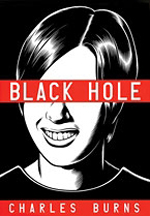A recent article at SciFi Scanner states that “marketing drones” have perpetuated the myth that science fiction and horror are different and mutually exclusive (and we might as well add romance to that list).
Well, thank goodness nobody told Charles Burns, whose brilliantly dark Black Hole is one of the best graphic novels of the past few years. It deftly mixes sex, adolescent angst, and a healthy dollop of Lovecraftian strangeness—delivering a unique mélange of horror, surreal science fiction, and romance.
In the spirit of the season, see why ripping off all of your skin and mutant coitus are such perfect complements.
Serialized for over a decade, Black Hole started off at Kitchen Sink Inc., known for its underground comics and anthologies. After that company folded in 1999, Fantagraphics Books picked up the mantle until the series’ conclusion. In 2005, Pantheon Books published the entire collection in one volume, allowing you to read this strange tale from start to finish.
Aside from its 1970s setting, you could lift most of the narrative from the latest CW teen sudser (if George Romero directed). Here’s the basic, spoiler-free plot:
Quiet Keith likes nice girl Chris, who yearns for bad boy Rob. All attend the same school; all play the preordained roles of their respective cliques. But that’s where any 90210 Walsh family allusions end.
Unlike the aforementioned TV twaddle, these kids’ lives ring painfully true. Many delve into the heady (and quite explicit) world of sex and drugs, as directionless teens everywhere are wont to do. This produces nightmarish results, submerging adolescent authenticity into an eerie ocean of magical realism.
It seems that after a night of carousing with a “bug”-infected partner, certain corporeal modifications appear—an extra mouth here, a prehensile tail there. Others have it worse as their flesh rots, leaving putrefied skulls in place of smiling faces. Unable to bear the shame, many of the infected shirk society and head into the darkened woods surrounding their Northwestern suburban hamlet.
The allusion to the HIV/AIDS virus is obvious, but I believe the allegory goes further than that.
Within its elegant black and white artwork, Black Hole crystallizes the horror of impending adulthood. Some go onto better things, while others can’t leave the protective blanket of adolescence. The future can indeed be a terrifying place.
Echoing Ghost World, “best friends forever” drift apart for no discernible reason, while the mundane life of grown-ups looms like an advancing Everest, ready to crush or lift all of its challengers. There are no easy answers; there is no definite conclusion. The story doesn’t just blend several genres—it transcends them.
Is Black Hole for everyone? No. Nothing is. But if you’re up for a sexy—albeit creepy—tale replete with stunning artwork, here’s your afternoon mint julep with a fresh sprig of rotting flesh.











This may indeed warrant a trip to the bookstore in the near future.
Black Hole really is an awesome comic. I should read it again